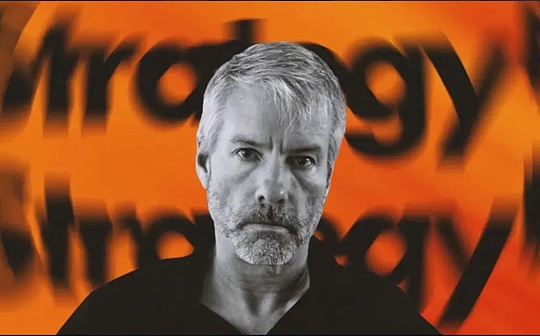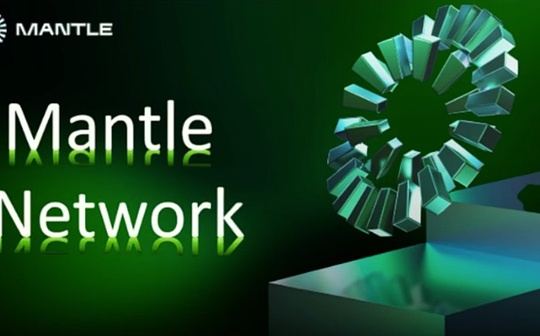
Original title: Plurality philosophy in an incredibly oversized nutshell
Author: Vitalik, founder of Ethereum; compiled by: 0xjs and Xiaozou@Bitchain Vision
An interesting contradiction in the crypto industry is its relationship to the governance theme, which has become my digital home as a geographical home for me over the past decade.The crypto industry stems from the crypto-punk movement, which values external constraints that are often exerted by ruthless and power-hungry politicians and corporations, and has long constructed technologies such as torrent networks and encrypted messaging to achieve these purposes.
However, with the emergence of new ideas such as blockchain, cryptocurrencies and DAO, an important shift has emerged: these newer structures are long-standing and evolving, so they have the inherent need to establish their own governance,And not just avoiding the governance of unwelcome outsiders.The continued survival of these structures depends mainly on mathematical research, open source software and other large public products.This requires a shift in mindset: maintaining the ideology of the crypto industry needs to go beyond the ideology that created it.
This complex interaction between coordination and freedom, especially in the context of new technologies, is ubiquitous in our modern society, far beyond blockchain and cryptocurrencies.Earlier this year, Florida Governor Ron DeSantis signed a bill that prohibits the state from producing synthetic (also known as “lab-grown”) meat, citing that “global elites want to control it.”Our behavior and the promotion of diets that feed on petri dishes and bugs to Americans, we need to “prioritize our farmers and ranchers over… World Economic Forum.”As you might expect, the Libertarian Party New Hampshire (LPNH) social accounts publicly criticized the “authoritarian socialist” nature of the legislation.But it turns out that many other self-proclaimed liberals do not agree with this view:
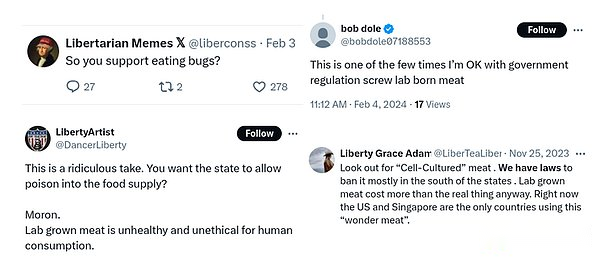
To me, LPNH’s criticism of the DeSantis ban makes perfect sense: banning people from eating a new, perhaps more moral and sustainable meat simply because of disgust is completely contrary to cherishing freedom.However, it is obvious that many people don’t think so.When I searched the internet for convincing arguments, the most convincing argument I could find is this argument from Roko Mijic:In short, once something like this is allowed, it becomes mainstream, society reorganizes around it, and the lives of those who don’t want to go with the flow will inevitably become more and more difficult.That’s the case with digital cash, even the Swedish central bank is concerned about the accessibility of cash payments, so why doesn’t this happen in other technology fields?
About two weeks after DeSantis signed a bill to ban lab-cultivate meat, Google announced that it would launch a feature in Android that will analyze calls in real time and automatically warn users if they think they might have been cheated.Financial fraud is an increasingly serious problem, especially in regions such as Southeast Asia, and they are becoming more and more complex, too fast to adapt.AI is accelerating this trend.Here we see Google is creating a solution to help warn users about scams, and, the solution is entirely client-side: it won’t send personal data to any business or government big brother.This seems magical; it’s exactly the kind of technology I advocated in my post introducing “d/acc”.However, not all free-thinking people are happy, at least one critic, Meredith Whittaker, president of Signal Foundation, who is also hard to be denounced as “just a Twitter troll.”
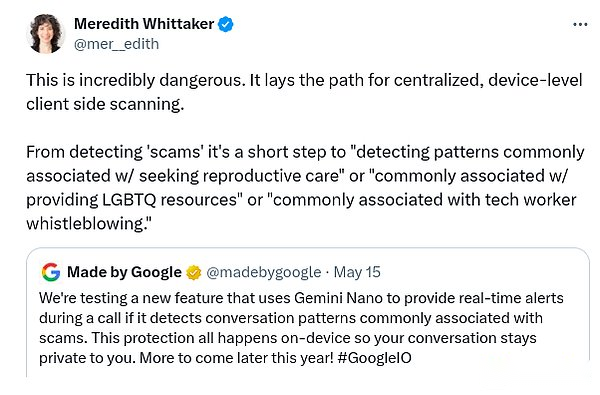
These three tensions are examples that keep me thinking about a profound philosophical problem:Like meWhat should people who consider themselves to be defenders of the principle of freedom actually defend?Does the updated version of this idea make sense in the twenty-first century when Scott Alexander believes that liberalism is a peace treaty?Obviously, the facts have changed.Public goods are much more important than before and are much larger in scale than before.The Internet makes communication rich, not scarce.As Henry Farrell analyzed in his book on weaponization interdependence,Modern information technology not only empowers the recipient, but also enables the creator to continuously project power.Existing attempts to deal with these issues are often disorganized, trying to see them as exceptions to the principle that needs to be tempered through pragmatic compromise.But what if there was a way of looking at the world in principle, which valued freedom and democracy, could incorporate these challenges and view them as normal rather than exceptions?
Table of contents of this article
-
The book “Plurality”
-
How can I define pluralism in one sentence?
-
What is the super politics of pluralism?
-
What is the multivariate model of “the true face of the world”?
-
How is pluralism different from liberalism?
-
How is pluralism different from democracy?
-
What specific technologies does the pluralism vision advocate?
-
identity
-
Multiple currencies and property
-
vote
-
dialogue
-
Brain communication and virtual reality
-
Where does pluralism lie in the contemporary ideological landscape?
-
Is pluralism compatible with an exponential future?
-
Is pluralism compatible with the emphasis on excellence and expertise?
-
Where can these ideas be applied first?
Introduction to the book “Plurality”
The above is not Glen Weyl and Audrey Tang introduced their new book, Plurality: the future of collaborative technology and democracySaid.Glenn’s narrative is slightly different, focusing on the increasingly antagonistic relationship between the numerous figures in the Silicon Valley tech world and the political center-left, and seeking a more collaborative path forward:
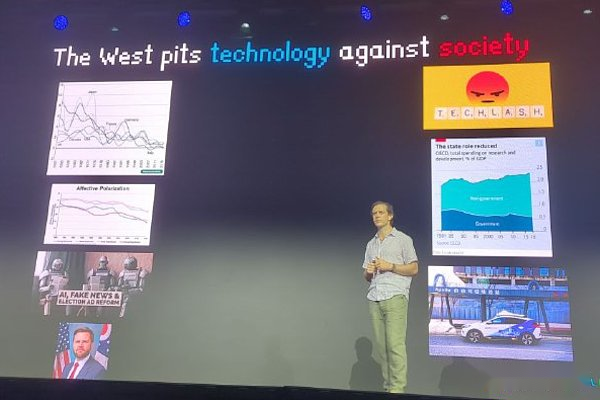
Glen Weyl introduces the book “Plurinationaly” in a speech in Taipei
But for me, introducing a series of related issues from my own perspective is more in line with the spirit of this book.after all,The explicit goal of Pluralism is to try to attract a wide range of people from various parts of the traditional political spectrum, with wide attention.I have long been concerned that in my opinion, support for democracy and even freedoms has been declining, and this decline seems to have accelerated since around 2016.
I have also played the role of a governance builder in the Ethereum ecosystem and dealt with governance issues personally.At the beginning of my journey to Ethereum, my initial dream was to create a mathematically optimal governance mechanism, just like we have a consensus algorithm that can be proven optimal.Five years later, my intellectual exploration finally led me to the theoretical argument why such a thing is mathematically impossible.
Glenn’s thought evolution is different from me in many ways, but there are many similarities.His previous book, Radical MarketExplain ideas inspired by classical liberal economics and the latest mathematical discoveries in the field,Try to create better versions of ownership and democracy to address the biggest problems of both mechanisms.Like me, he always thought both liberal and democratic thought were compelling and tried to find an ideal combination of the two, seeing them as opposing goals that need balance, rather than two sides of the same coin that needs integration.Recently, like my case, the mathematical part of his social thought is also towards the direction of trying to see not only individuals but also connections as first-class objects that any new social design needs to consider and build around itDevelop, not treat it as a mistake that needs to be eliminated.
Glenn and Audrey’s book “Pluripotence” is written in the spirit of these ideas and the spirit of emerging transformation from theory to practice.
How can I define pluralism in one sentence?
Glen Weyl has the brilliance of pluralism in his 2022 article Why I Am A Pluralist:
The pluralism I understand is a social philosophy that recognizes and promotes prosperity and cooperation among different socio-cultural groups/systems.
If I had to expand on this a little bit and define the book with four key points, I would say the following:
-
Glenn’s Super Politics:The world today is trapped in a narrow passage between conflict and centralization, and we need a new, upgraded, high-performance form of digital democracy to replace both.
-
Multiple atmosphere:The overall theme is: (i) we should understand the world through patchwork of models rather than trying to extend any single model beyond its natural applicability; (ii) we should take the connection between individuals seriously and strive toExpand and strengthen healthy connections.
-
Design of pluralism heuristic mechanism:There is a set of principled mathematical techniques through which social, political and economic mechanisms can be designed that not only regard individuals as primary objects, but also the connections between individuals as primary objects.Doing so can create newer markets and democratic forms that address common problems in today’s markets and democracy, especially in bridging tribal divisions and polarization.
-
Audrey’s practical experience in Taiwan:During his tenure as Digital Minister of Taiwan Province, Audrey has incorporated many concepts of diverse orientations, which is the starting point for learning and reference.
What is the super politics of pluralism?
In Balaji Srinivasan’s masterpiece “National” , Balaji describes his view of the world today, believing that the world is divided into three poles: the center-left English circle represented by the New York Times (NYT)Elite, communism, and extreme individualist right-leaning people represented by Bitcoin (BTC).Glenn gave his own description of “21st Century Political Ideology” in his book “Politics” and elsewhere, as follows:
 The names of these three are taken from Civilization 6, and in the book Pluralism, Glenn simplifies their names to technological domination, liberalism, and pluralism.His description of these three is roughly as follows:
The names of these three are taken from Civilization 6, and in the book Pluralism, Glenn simplifies their names to technological domination, liberalism, and pluralism.His description of these three is roughly as follows:
-
(Synthetic) Technological domination:Some mechanism run by AI and a handful of human elites creates a lot of amazing things and ensures that everyone gets the share they need to live a good life (for example through UBI).Non-elite political opinions are considered unimportant.Examples of this ideology include China, the World Economic Forum (“You will have nothing, but you will be happy”), UBI advocated by Sam Altman and his friends, and from my recent trips, I may also addDubai Future Museum.
-
(Company) Liberalism:Maximize property rights and contractual freedom and expect the most important projects to be initiated by some kind of “great founder” entrepreneur.Individuals are almost entirely protected from abuse by their right to “quit” any system that becomes too inefficient or exploitative.Examples of this ideology include books such as “Social Individual”, free city movements such as “Prospera”, and online countries.
-
Digital Democracy/Pluralism:Using Internet technology to create democratic mechanisms with higher bandwidth can aggregate preferences from a wide range of people and use these mechanisms to create stronger and more effective “third sectors” or “civil society” to make better decisions.Glenn cited examples include both novels, most famously any works by Star Trek and Ursula le Guin, as well as real-life prototypes, the most famous onesIt is the e-government in Estonia and Taiwan.
Glenn believes that pluralism can avoid three modes of failure at the same time: coordination failure leads to conflict (he believes that liberalism has this risk), centralization and authoritarianism (he believes that technological domination has this risk), and stagnation (he believes that the “old world”Democracy has this risk that it loses competitiveness in competition with liberalism and technological domination).Glenn believes that pluralism is an underexplored alternative, and his project will enrich the idea, while Audrey’s project will be implemented first in Taiwan, China and then elsewhere.
If I were asked to summarize the difference between Balaji’s plan and Glenn and Audrey’s plan, I would summarize it as follows.Balaji’s vision revolves around creating new alternative institutions and new communities around these new institutions and creating safe spaces that give them a chance to grow.On the other hand, Glenn and Audrey’s approach is best reflected in the “fork and merge” strategy of Taiwan’s e-government:
So when you visit a regular government website, change O to 0, this domain hack ensures that you are viewing the shadow government version of the same website, except that it is on GitHub, but it is powered by open data, but onlyThere is real interaction and you can actually discuss any budget project with your fellow citizen hackers around this visualization.
Many projects in Gov Zero have become so popular that the government and ministries eventually merged their code, so if you visit the official government website, it looks exactly the same as the citizen hacker version.
There are still some choices and exits in Audrey’s vision, but there is a tighter feedback loop through which the improvements brought by micro exits will reintegrate into the “mainline” social infrastructure.Balaji will ask: How can we let synthetic meat people have their synthetic meat city and let traditional meat people have their traditional city?Glenn and Audrey might ask: How do we build the top of society to ensure that people are free to do anything while still retaining the benefits of collaborating as part of the same society and working in every other way?
What is the multivariate model of “the true face of the world”?
The pluralist’s view on how to improve the world begins with the view of how to describe the status quo of the world.This is a key part of Glenn’s evolution, because Glenn’s perception of these issues was more inspired by economics a decade ago.Therefore, it is beneficial to compare and contrast the worldview of pluralists with the worldview of traditional economics.
Traditional economics focuses primarily on a few economic models that make specific assumptions about how the subject works and regard behaviors that deviate from these models as flaws, with consequences not too serious in practice.As given in the textbook, these assumptions include:
-
compete:Common situations of market efficiency rely on the assumption that no market participant is large enough to significantly influence market prices through their behavior—instead, the price they set only determines whether someone buys their products.
-
Complete information:People in the market are fully aware of the products they are buying
-
Completely rational:People in the market have consistent goals and are committed to achieving these goals (they can be altruistic)
-
No externalities:The production and use of items traded on the market affects only the producer and user, and not the third party that has nothing to do with you.
In my own recent articles, I usually emphasize a more competitive but stronger assumption: independent choice.If you assume people act independently in pursuit of their own independent goals, many mechanisms proposed by economists will work perfectly, but once participants coordinate their actions through some mechanism outside of the rules you set, they will be veryCrash soon.Second price auctions are a good example: if the above conditions are met and the participants are independent, they can prove to be completely valid, but if the highest bidder can collude, they will crash seriously.Quadratic financing invented by me, Glen Weyl and Zoe Hitzig is similar: if the participants are independent, it is a proven ideal mechanism for funding public goods, but if even two participants collude, theyUnlimited funds can be withdrawn from this mechanism.My own work on pairwise-bound quadratic financing is trying to fill this loophole.
But once you start analyzing extremely important social parts that don’t look like trading platforms, the practicality of economics will drop further.Take the conversation as an example.What are the motivations of the speaker and listeners in a conversation?As Hansen and Simler pointed out in The Elephant In The Brain, if we try to model conversations as information exchange, we see people tightly protecting information and trying toPlay tit-for-tat game, and the conversation is just for someone else’s response.However, in reality, people are often eager to share information, and criticism of people’s dialogue behavior is often focused on the tendency of many to say too much and listen too little.In public conversations such as social media, a major analysis of what kind of statements, claims, or memes will survive quickly (go viral)—a term that directly acknowledges that the most natural field of analogy science is not economics, but biologystudy.
So what are the alternatives for Glenn and Audrey?A large part of this is simply acknowledging that there is no single model or scientific method that can perfectly explain the world, and we should use a combination of different models to recognize the limitations of the applicability of each model.In a key part, they wrote:
Mathematics of the 19th century witnessed the rise of formalism: precise and rigorous treatment of the definitions and properties of mathematical structures to avoid inconsistencies and errors.In the early 20th century, people hoped that mathematics could be “solved” and might even give an accurate algorithm to determine the authenticity of any mathematical claim.[6] On the other hand, 20th century mathematics is characterized by a surge in complexity and uncertainty.
Godel’s theorem: Some mathematical achievements in the early 20th century, most famously Gödel’s theorem, show that there are some basic and irreducible ways to completely solve the key parts of mathematics.
Computational complexity: Even if reductionism is theoretically/theoretical, the amount of computation required to predict a more advanced phenomenon based on its components (its computational complexity) is very large, so it is unlikely to have practical significance to perform it.
Sensitivity, chaos and irreducible uncertainty: Many even relatively simple systems exhibit “chaotic” behavior.If a slight change in the initial condition causes a fundamental change in its final behavior after a long period of time, the system is chaotic
Fractal:Many mathematical structures have been shown to have similar patterns on different scales.The Mandebrot collection is a good example.
Glen and Audrey continue to give similar examples from physics.As one of the many co-contributors in the writing of this book, I contributed and accepted it by them, which is:
Three-body problem,It is well known for playing an important role in Liu Cixin’s science fiction series.The problem shows that even under simple Newtonian physics, the interaction between the three bodies is so chaotic that it is impossible to predict its future behavior with simple mathematical problems.However, we can still regularly use 17th-century abstract concepts such as “temperature” and “pressure” to solve the trillion-dollar problem, and these abstract concepts are sufficiently applicable to everyday applications.
In biology, a key example is:
Similarities between organisms and ecosystems:We found that many different organisms (“ecosystems”) can exhibit similar characteristics to multicellular life (home balance, susceptibility to destruction or excessive reproduction of internal components, etc.), reflecting their emergence and multi-scale organization.
At this point, the subject matter of these examples should be easy to understand.No model can be applied globally, and the best thing we can do is piece together multiple models that work well in multiple situations.The underlying mechanisms of different sizes are not the same, but they do “rhyme”.They believe that social science needs to develop in the same direction.They believe that this is where “technical domination” and “liberalism” fail:
In the technocratic vision we discussed in the previous chapter, the “chaos” of the existing administrative system will be replaced by large-scale, unified, rational, scientific, and AI planning systems.This unified subject transcends locality and social diversity and is considered to be able to give “just” answers to any economic and social issues, beyond social divisions and differences.Therefore, it seeks not to cultivate and utilize social diversity and heterogeneity, but to mask them in the best case and erase them in the worst case, which the social science believes are precisely these diversity and heterogeneityQualitativeness determines people’s interests, participation and value.
In the vision of the liberals, the sovereignty of the atomic individual (or in some versions, a homogeneous and closely coherent group of individuals) is the core aspiration.Social relations are best understood from the perspective of “client,” “exit,” and other capitalist dynamics.Democracy and other means of dealing with diversity are seen as failure modes of systems that cannot achieve adequate coordination and freedom.
One specific model that Glenn and Audrey repeatedly mention is George Zimmer’s theory of personality, which argues that personality originates from the unique intersection of different groups of individuals.They describe this as a third option beyond “atomic individualism” and collectivism.They wrote:
In the view of [Georg Simmel], humans are highly socialized creatures, so their identity is formed through social relations.Humans gain key aspects of self-awareness, goals and meaning through participation in society, language and solidarity groups.In simple societies (e.g., isolated, rural or tribal), people spend most of their lives interacting with the kinship groups we describe above.This circle (mainly) collectively defines their identities, which is why most scholars who study simple societies (e.g., anthropologist Marshall Sahlins) tend to support methodological collectivism.[14] However, as we mentioned above, social relations become diversified as society urbanizes.People work in one circle, worship in another, support political causes in the third circle, entertain in the fourth circle, cheer for sports teams in the fifth circle, think in the sixth circleI am discriminated against myself, etc.
When this happens, the self-awareness that people share with those around them gradually decreases at any time; they begin to feel “unique” (see with a positive perspective) and “isolated/misunderstood” (see with a negative perspective)).This creates a sense of what he calls “personal characterization,” which helps explain why social scientists (such as economists) who focus on complex urban environments tend to support methodological individualism.Ironically, however, as Zimmel pointed out, this “individualization” is precisely because the “individual” splits among many loyalties, thus splits.
This is the core idea that the book “Plurinational” repeatedly reiterates: regard the connection between individuals as the primary object in mechanism design, rather than just focusing on the individual itself.
How is pluralism different from liberalism?
In his 1974 book Anarchy, State and Utopia, Robert Nozick advocates the establishment of a minimal government that performs basic functions such as preventing people from launching violent actions, but other functions arePeople organize themselves into communities that match their values.Since then, the book has become a manifesto for many classical liberals to describe the ideal world.
I think of two examples, one is Robin Hanson’s recent article Liberalism as Deep Multiculturalism, and the other is Scott Alexander’s 2014 article “The Islands and the Atomic Society” published by Scott Alexander in 2014》》.Robin was interested in the concept because he wanted to see a world with more of what he called deep multiculturalism:
The superficial “multiculturalism” tolerate and even praises various cultural symbols such as clothing, food, music, mythology, art, furniture, accents, festivals and deities.But it usually has much lower tolerance for various cultural values, such as war, sex, race, childbirth, marriage, work, children, nature, death, medicine, school, etc.It seeks a “mutual understanding” that once we go beyond different signs, we are actually (or should) the same.
On the contrary, deep “multi-culturalism” accepts and even praises the coexistence of multiple cultures that have completely different values.It seeks to make the world, even geographical areas, embrace these different cultures in a peaceful and prosperous environment.It expects that due to differences in values, there will be some distrust, conflict and even hostility between different cultures.But it believes that this is the price of deep cultural diversity.
Since the main purpose of most non-liberal government activities is to create and maintain a common community/culture and its values, this impulse to use government to promote a common culture seems to be a major obstacle to liberal governance.That is, liberals want to share government rather than community or culture.The usual political axis of “liberalism” and “nationalism” may be seen as about the extent to which we wish to share culture, rather than allowing different cultures to be
Scott Alexander reached a similar conclusion in his 2014 article, although his basic goal was slightly different: He hoped to find an ideal political structure that creates opportunities for organizations to support the public goodand limit culturally subjective public bad behavior, while limiting subjective arguments about higher-order harm (“homosexuality is corroding social structures”) to become a common trend in masks of oppression.Balaji’s Cyber Nation is a more specific social structure proposal that tries to achieve the exact same goal.
therefore,A key question worth asking is: In what aspects does liberalism not be enough to achieve a diverse society?If I had to summarize the answer in two sentences, I would say:
-
Pluralism means not only achieving diversity, but also utilizing diversityand more actively work to establish higher-level institutions, maximize positive and interactive interactions among different groups and minimize conflict.
-
Pluralism exists not only at the social level, but also within each individual,Allows each individual to be part of multiple tribes at the same time.
To understand (2), we can enlarge a specific example.Let’s take a look at the opening part of the debate surrounding Google’s device anti-fraud scanning system.On the one hand, a tech company released a product that seemed to be out of a sincere desire to protect users from financial fraud (this is a very realistic question, and people I know have lost hundreds of thousands of dollars as a result),It even goes a step further, checking the most important “password punk values” box: the data and calculations are completely retained on the device, it is purely to warn you, not to report you to law enforcement.On the other hand, we see Meredith Whittaker, who sees the product as a landslide to something more oppressive.
Now let’s look at Glen’s preferred alternative: a Taiwanese app called Message Checker.Message Checker is an app that runs on your phone that intercepts incoming message notifications and analyzes them.It includes features that are not related to scams, such as using client algorithms to identify the most important messages to you.But it can also detect scams:
 A key part of the design is that the app does not force all users to a unified set of rules.Instead, it gives the user the option to turn on or off:
A key part of the design is that the app does not force all users to a unified set of rules.Instead, it gives the user the option to turn on or off:

From top to bottom: URL check, cryptocurrency address check, rumor check.
These are filters made by the same company.A more ideal setup is to have it as part of the operating system and have an open market where you can install different filters created by a variety of different commercial and nonprofit players.
The key multivariate feature of this design is that it provides users with finer granular freedom of exit, avoiding all or nothing.If it could be established that the device anti-fraud scan must work this way, it seems that it would make Meredith’s dystopia unlikely to happen: If the operator decides to add a filter, the care of transgender peopleInformation (or, if your fears are moving in another direction, proposing a restriction on gender self-categorization in track and field competitions) is considered dangerous content, then individuals can simply not install that specific filter and they can still get from the restbenefit from anti-fraud protection.
An important revelation is that “meta-institutions” need to be designed to encourage other institutions to respect this fine-grained ideal of exit freedom——After all, as we see in software vendor lock-in, organizations won’t automatically follow this principle!
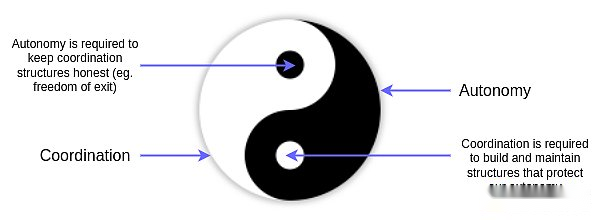 A way to think about the complex interaction between coordination and autonomy in pluralism.
A way to think about the complex interaction between coordination and autonomy in pluralism.
How is pluralism different from democracy?
Once you read the chapter on voting, many of the differences between pluralism and traditional democracy become clear.The multi-voting mechanism has some strong and clear answers to the question of “democracy is two wolves and one sheep who votes to decide what to eat” and the concerns about the declining democracy to populism.These solutions build on Glen’s early ideas about quadratic voting, but go further, if these votes come from more independent participants from each other, the votes are explicitly counted into a higher proportion.I will cover this in more detail in the later section.
In addition to the significant theoretical leap from only computing individuals to computing connections, there are broad thematic differences between the two.A key difference is the relationship between pluralism and nation-state.Liberal philosopher Chris Freiman summed up a major drawback of nation-state democracy in this tweet, which is very inspiring to me personally:
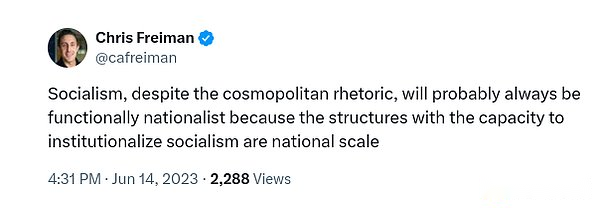 This is a serious gap: two-thirds of global inequality occur between countries, not within countries,More and more public products (especially digital products) are neither global nor explicitly linked to any particular nation-state, and the tools we use to communicate are highly international.Democratic plans for the 21st century should take these fundamental facts more seriously.
This is a serious gap: two-thirds of global inequality occur between countries, not within countries,More and more public products (especially digital products) are neither global nor explicitly linked to any particular nation-state, and the tools we use to communicate are highly international.Democratic plans for the 21st century should take these fundamental facts more seriously.
Pluralism is not essentially opposed to the existence of nation-states, but it explicitly strives to go beyond the category of relying on nation-states as a center of action.It provides action guides for various actors, including multinational organizations, social media platforms, other types of businesses, artists, and more.It also explicitly acknowledges that for many people, there is no single nation-state that can dominate their lives.
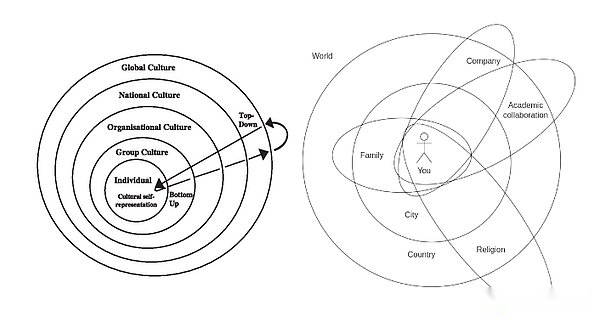 Left picture: Concentric circle social view, excerpted from a 2004 sociological paper.Picture on the right: Multi-society: a circle that intersects each other but does not distinguish between hierarchies.
Left picture: Concentric circle social view, excerpted from a 2004 sociological paper.Picture on the right: Multi-society: a circle that intersects each other but does not distinguish between hierarchies.
Ken Suzuki’s Smooth Society and its Enemies elaborates on an important theme of pluralism in more detail: membership in an organization should not be considered a question of “right or wrong”.Instead, there should be different levels of membership, which will bring different benefits and different levels of obligation.This is an aspect of society, it has always been right, but it has become even more important in an internet-first world where our communities are no longer necessarily nested and completely overlapping.
What specific technologies does the pluralism vision advocate?
The book Pluralism advocates a fairly broad range of digital and social technologies that cover areas traditionally considered to be large “space” or industries.I’ll highlight several examples in specific categories.
identity
First, Glenn and Audrey criticized the existing approach to identity.Some key quotes on this topic:
Many of the easiest ways to establish an identity are destroyed at the same time, especially online.Passwords are often used to establish an identity, but unless such authentication is very cautious, passwords may be leaked more widely, making passwords useless in future authentication, as attackers will be able to impersonate them.”Privacy” is often considered to be “better if there is,” and is especially useful for those who “have something to hide.”But in the identity system, protecting private information is the core of practicality.Any useful identity system must be judged based on its ability to establish and protect identity at the same time.
About biometrics:
[Biometric Identification] There are significant restrictions on identifying and protecting identities.Related such a wide range of interactions with a single identifier associated with a set of biometric information collected from a single individual at the time of registration (or registration), forces people to make a serious trade-off.On the one hand, if (as Aadhaar) the administrators of the program are constantly using biometrics to authenticate, they can connect activities with the activities of the person whose identifier points to or see them, thus gaining unprecedented capabilities toMonitor civic activities in a wide range of areas and have the potential to undermine or target the identities of vulnerable groups.
On the other hand, if, like Worldcoin, only biometrics are used to initialize the account, the system will easily be stolen or sold. This problem has seriously affected the operation of related services… If at some point in the future, the eyeball can be deceived by AI systems combined with advanced printing technology, so such a system may experience extreme “single-point failure”.
Glen and Audrey prefer to do this by using an intersecting social identity approach: leverage one’s entire behavior and interaction to achieve the fundamental goals of the identity system, such as determining the degree of community members and one’s credibility:
This socialized and diversified approach to online identities was pioneered by Danah Boyd in her visionary master’s thesis on “multi-faced identity.”[28] While she focuses primarily on the benefits of such a system for a sense of personal agency (in the spirit of Zimmel), its potential benefits for the balance between identity establishment and protection are even more surprising:
Comprehensive and redundancy: There are people and institutions (usually many) who can “guaranteed” this information for almost anything we may want to prove to strangers without any specialized surveillance strategies.For example, people who want to prove that they are older than a certain age can turn to friends who have known them for a long time, the schools they attend, doctors who have verified their age at different times, and of course governments that have verified their age.
Privacy:Perhaps more interesting is that the “publishers” of all these attributes learn this from interactions most people think are consistent with “privacy”: we don’t worry about the common knowledge of these social facts as much as we worry about company or government surveillance.
Security:Pluralism also avoids many “single-point failure” problems.Even the corruption of several individuals and institutions only affects those who depend on them, and those people may be only a small part of society, even for them, the above redundancy means they may only suffer from them.Partial reduction in the verification capability that can be achieved.
Restorative:Individuals can rely on a set of relationships, such as 3 out of 5 friends or institution to recover their keys.This “social recovery” has become the gold standard for many Web3 communities and has even been increasingly adopted by major platforms such as Apple.
The core information is that any single factor technology is too fragile, so we should use multi-factor technology.For account recovery, it is relatively easy to understand how it works, and it is easy to understand the security model: each user chooses what they trust, and if a user makes the wrong choice, the consequences are mainly limited to that user.However, other use cases for identity are more challenging.For example, UBI and voting seem essentially to require global (or at least the entire community) to agree on who the community members are.However, some people work hard to bridge this gap and create something close to “feeling” like a single global thing while being based on subjective multi-factor trust.
The best example in the Ethereum ecosystem is Circles, a UBI token project based on the “trust network”, where anyone can create an account (or an unlimited number of accounts) that generates 1 CRC per hour, but only if thatOnly when the account is connected to you through a trust network graph will you consider the coins of a given account as “real Circles”.
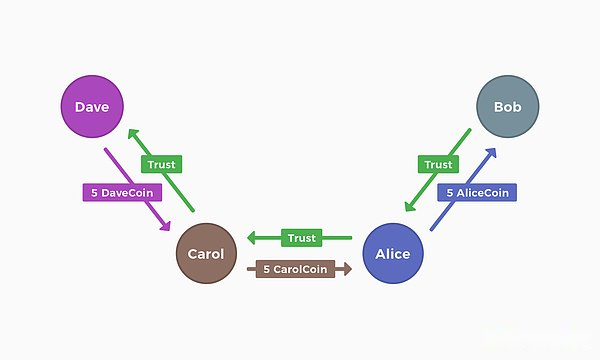
The spread of trust in Circles, excerpted from the Circles white paper
Another way is to completely abandon the abstract concept of “you are either human or not”, try to use multiple factors to determine the credibility and membership of a given account and give it a UBI proportional to that score orVoting rights.Many airdrops ongoing in the Ethereum ecosystem, such as Starknet airdrops, follow such principles.
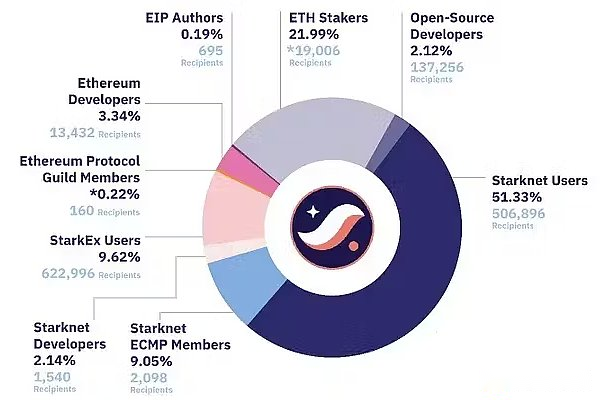
Starknet airdrop receiver category.Many recipients end up falling into multiple categories.
Multiple currencies and property
In “Aggressive Markets,” Glenn focused on “stable and predictable, but intentionally imperfect” versions of ownership, such as the Hamberg Tax.He also focused on the “market-like” structures that could fund public goods rather than just private goods, most notably quadratic voting and quadratic financing.These two ideas are still prominent in Pluralism.The non-monetary implementation of quadratic financing is called Plural Credits, which is used to help record the contributions of the reconciliation book itself.The idea around Hamberg Tax has been updated to try to extend this idea to a mechanism that allows assets to be owned by multiple different individuals or groups simultaneously.
In addition to continuing to emphasize super-large-scale market design, one of the new additions to the plan is to pay more attention to community currency.:
In a multi-center structure, various communities will have their own currencies that can be used in limited areas rather than a single universal currency.Such as housing or education vouchers, bus tickets at markets, or letters of credit for buying various stall food at universities.[18] These currencies may be partially interoperable.For example, two universities in the same town may allow exchanges between their food stamps.But if the holder sells community currency to a wider currency without the community’s consent, it is not possible to violate the rules and even technically.
The fundamental goal is to combine local mechanisms that deliberately maintain localization with global mechanisms to achieve large-scale cooperation.Glenn and Audrey believe their revised version of the market and property are the best candidates for the largest global collaboration:
Those who pursue pluralism should not want the market to disappear.There must be something to coordinate coexistence between the widest social distancing, if not cooperation, and many other ways to achieve this, even insignificant ways like voting, face greater risks of homogeneity, because they involve deeper connections.Socially conscious global markets offer greater prospects for pluralism than global governments.The market must develop and thrive with many other models of cooperation to ensure a diverse future.
vote
In Radical Markets, Glenn advocates quadratic voting, a voting method that addresses the problem that allows voters to express preferences of varying intensity, but at the same time avoids the most extreme or resource-rich voice-led failure modes that dominate decisions.In the book Pluralism, the core problems Glenn and Audrey are trying to solve are different, and the following section summarizes the new problems they are trying to solve:
It is natural but misleading to give a party that has twice the legitimate interest in a decision.The reason is that this usually gives them more than twice the power.On average, inconsistent voters offset each other, so the total influence of 10,000 fully independent voters is much smaller than that of a person with 10,000 votes.
When the background signal is completely uncorrelated and numerous, there is a simple mathematical method to explain this: the growth rate of a series of uncorrelated signals is the square root of its number, and the growth rate of the correlation signal is linearly proportional to its intensity.Therefore, the weight of 10,000 unrelated votes is as large as that of 100 related votes.
To solve this problem, Glenn and Audrey advocate designing a voting mechanism using the principle of “decreasing proportion”: adding unrelated signals, but only sqrt(N) votes are given to N related signals.
This approach has precedents in national and international organizations such as the United States, which usually have a certain number of voting rights to sub-units (the former is the state and the latter is the state) which are related to their population or economic strength.proportional, while other councils give each subunit one voting right, regardless of its size.In theory, ten million voters in a large state are more important than one million voters in a small state, but the signals they represent are more relevant than ten million voters from ten different states, so a large stateThe voting rights of ten million voters should be between these two extremes.

Left picture: U.S. Senate, each state has two senators, no matter how big or small.Picture on the right: The Electoral College of the United States, the number of senators is roughly proportional to the population.
Of course, the key challenge for such design to work more generally is to determine who is “unrelated”.Participants in concert acted pretending to be inconsistent to increase their legitimacy (also known as “false propaganda,” “decentralized real-life interpretation,” “puppet state”…) have been a mainstream political strategy and have been around for centuries.If we instantiate a mechanism to determine who is relevant to whom by analyzing Twitter posts, people will start to craft their Twitter content to make it look as unrelated as possible in the algorithm, and may even deliberately create and use a bot to do it.To this point.
Here I can propose my own solution to this problem: vote on multiple issues at the same time and use the vote itself as a signal of who is related to whom.One implementation is paired quadratic financing, which allocates a fixed budget to each pair of participants and then allocates according to the intersection of the pair’s voting methods.You can do something similar to voting: not to give each voter one vote, but to give each pair of voters one voter (dividable):
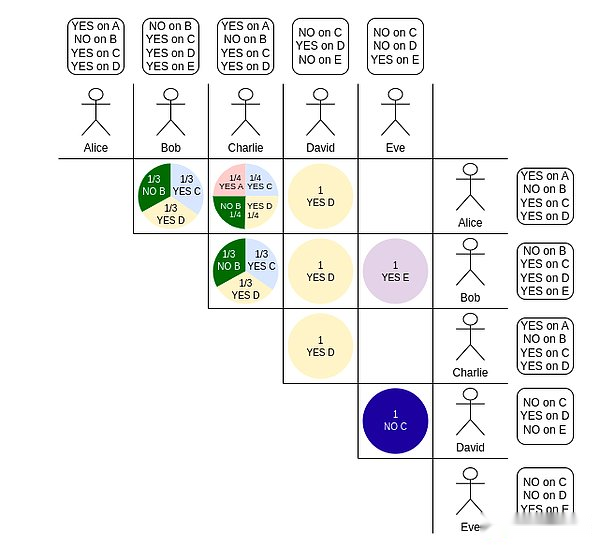
If calculated by the original number, the vote for favor won 3-2 on question C.But Alice, Bob and Charlie are highly relevant voters: they agree on almost everything.Meanwhile, David and Eve agree only on C.In pairs, (David, Eve) votes in all “opposition to C” will be assigned to C, which is enough to overwhelm Alice, Bob and Charlie’s “opposition to C” votes, whose pairs of votes on C add upOnly 11/12.
The key trick in this design is that determining who is “related” and “unrelated” is an inherent part of the mechanism.The more consensus the two participants reached on one issue, the less votes they voted on all other issues.A group of 100 “organic” diverse participants will receive considerable voting weights, as the overlapping area of any two participants is relatively small.Meanwhile, a group of 100 people with similar beliefs and listening to the same media will receive lower weights because they have a larger overlap area.A set of 100 accounts are all controlled by the same owner and they will have perfect overlap as this is the strategy to maximize owner goals, but they will get the lowest weight.
This “pairing” approach is not mathematically an ideal way to achieve such things: in the case of quadratic financing, the amount of funds that an attacker can withdraw grows with the square of the number of accounts they control, and the idealIt should be linear in the case.How to specify an “ideal” aspect of mechanism, whether it is quadratic financing or voting, has the most powerful attributes when facing attackers who control multiple accounts or related voters, and this is an open research question.
This is a new type of democracy that naturally corrects the phenomenon that sometimes labels “NPC” in Internet discourse:A large group of people may be just one person because they all consume the exact same source of information and believe in the exact same things.
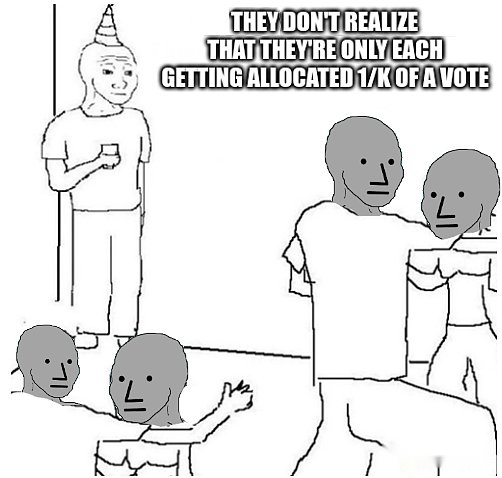
dialogue
As I have said many times, especially in the context of DAO, the success or failure of governance depends on the formal governance mechanism and about 80% on the communication participants have before they determine their opinions and enter them into governance.structure.To do this, Glen and Audrey also spent a lot of time thinking about better technologies for large-scale conversations.
One of the dialogue tools they focus on is Polis.Polis is a system that allows people to submit statements about a problem and vote on each other’s statements.At the end of a round, it identifies different major “clusters” in different perspectives and lists statements that best get support from all clusters.
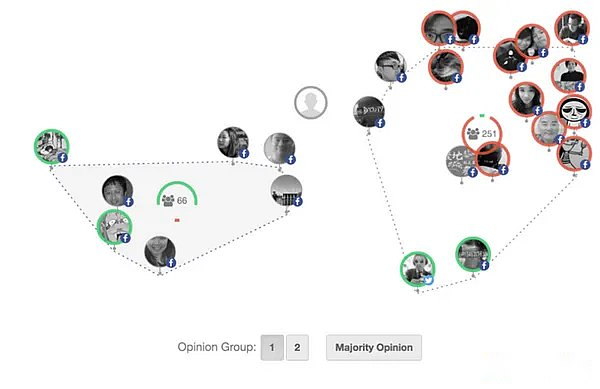 Source: https://words.democracy.earth/hacking-ideology-pol-is-and-vtaiwan-570d36442ee5
Source: https://words.democracy.earth/hacking-ideology-pol-is-and-vtaiwan-570d36442ee5
In fact, Polis has been used in public discussions on some legal proposals in Taiwan, China, including setting rules for ride-hailing services like Uber.Polis has also been used in other occasions around the world, including some experiments within the Ethereum community.
The second tool they focus onGreater success in becoming mainstream, but largely due to the “unfair advantage” of its introduction to an existing social media platform with hundreds of millions of users:Community Notes on Twitter.
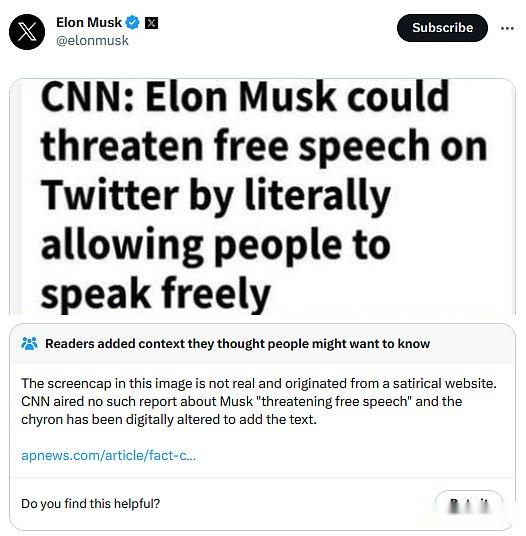 Community Notes also uses an algorithm that allows anyone to submit proposed comments for posts and displays comments that give the highest ratings for those who disagree with most other comments.I describe this algorithm in more detail in my comments on the platform.Since then, Youtube announced that they plan to launch similar features.
Community Notes also uses an algorithm that allows anyone to submit proposed comments for posts and displays comments that give the highest ratings for those who disagree with most other comments.I describe this algorithm in more detail in my comments on the platform.Since then, Youtube announced that they plan to launch similar features.
Glen and Audrey hope that the concepts behind these mechanisms can be expanded and applied more widely across the platform:
While [Community Notes] currently puts all opinions on the entire platform in one scope, we can imagine drawing a series of communities within the platform and leveraging its bridging-based approach that not only prioritizes notes but also prioritizes first.Consider content to attract attention.
The ultimate goal is to try to create a large discussion platform, which is designed not to maximize indicators such as “participation”, but to intentionally optimize consensus points among different groups.Mutual benefit, but also identify and utilize every possible opportunity for cooperation.
Brain communication and virtual reality
Glenn and Audrey spent two full chapters discussing “post-symbol communication” and “immersive shared reality.”The goal here is to spread information between people in a way that is much higher than the bandwidth that markets or dialogues can achieve.
Glenn and Audrey describe an exhibition in Tokyo that allows visitors to feel the feeling of getting older:
The sun visor blurs vision and mimics cataracts.The treble of the sound is stripped.In the photo booth reflecting the test of old age perception, facial expressions become blurred.In the bustling market, the simple act of recalling a shopping list that is kept in mind becomes an adventure.Wearing heavy objects on your ankles and stepping in place and leaning against your shopping cart simulates the wear of time on your body or the weight of age on your posture.
They argue that in the future, using technologies such as brain-computer interfaces can achieve more valuable and realistic experiences.“Immersive shared reality” covers what we commonly call “virtual reality” or “metauniverse”, but has a wider scope than that, and is described as a design space between postsymbol communication and dialogue.
Another book I have read on a similar topic recently is Herman Narula’s Virtual Society: A New Frontier in the Metaverse and Human Experience.Herman focuses on the social value of the virtual world and how the virtual world supports coordination within society when it is given the right social meaning.He also focused on the risks of centralized control, believing that the ideal metaverse should be created by organizations that are more like nonprofit DAOs than traditional companies.Glen and Audrey have very similar concerns:
Enterprise Control, Surveillance and Monopoly: ISR blurs the line between public and private, and digital spaces can be both private and open to a wide audience or viewed by enterprise service providers.Unless ISR networks are constructed based on the principles of rights and interoperability that we emphasize above and are managed by a wider approach to multi-governance that most of the rest of this book is dedicated to, they will be the ironiest we knowmonopoly cage.
If I were asked to point out a difference in their vision, that was it.Virtual Society focuses more on the shared storytelling and long-term continuity of the virtual world, pointing out how games like Minecraft win the hearts of hundreds of millions of people, although by modern standards, it is very limited from the perspective of cinematic immersion.On the other hand, pluralism seems to focus more on (but far from the only) sense of sensory immersion and is more receptive to short-term experiences.The argument holds that sensory immersion has a unique and powerful ability to convey certain information that we are difficult to obtain.Time will tell us which of these visions, or which combination of the two will succeed.
Where does pluralism lie in the contemporary ideological landscape?
When I look back at the political changes we have seen since the early 2010s, one thing that impressed me isSports that have succeeded in the current environment seem to have one thing in common: they are both object-level, not meta-level.That is to say,They seek to promote a broad general principle on how to solve social or political problems, but rather a specific position on specific issues.Some examples that come to mind include:
-
YIMBY:Representative “Yes, In My Back Yard”, the YIMBY campaign aims to combat highly restrictive zoning regulations such as the San Francisco Bay Area and to expand freedom to build housing.If successful, they think this will reduce the largest single component of the cost of living for many and increase GDP by up to 36%.YIMBY has achieved many political victories recently, including a major zoning liberalization bill in California.
-
Crypto Industry:Ideologically, the industry represents the principles of freedom, decentralization, openness and anti-censorship.In practice, most crypto industries end up focusing more on the openness of the global financial system and the freedom to hold and consume funds.
-
Extend lifespan:Using biomedical research to figure out how to intervene before the aging process develops to the extent of the disease, potentially giving us a longer (and completely healthy) life span, the concept has become mainstream over the past decade.
-
Effective altruism:Historically, the effective altruism movement represents a widespread application of a formula: (i) care about doing the most good things, (ii) strictly determine which charities actually achieve this, and point out that some charities are more than othersThousands of times effective.Recently, however, the most prominent part of the movement has turned to the single issue of AI security.
In modern movements that are not driven by problems in this way, a large part can be seen as a vague cult of personality, centered around any set of positions taken and changed in real time by a leader or a handful of well-coordinated elitesLet’s unite.There are also movements that may be criticized as ineffective and inconsistent, constantly trying to impose a changing list of causes under a umbrella of an umbrella of an unclear, unprincipled “Omnicause”.
If I had to ask myself why these shifts occurred, I would say this: Large groups have to coordinate around certain things.And the reality is that you either (i) coordinate around principles, (ii) coordinate around a task, or (iii) coordinate around a leader.When an existing set of principles is considered outdated and inefficient, the other two alternatives will naturally become more popular.
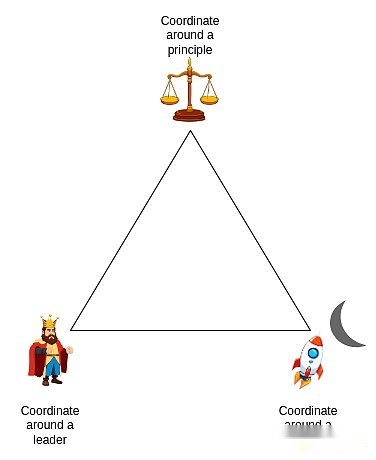 Coordinating around a task is effective, but it is temporary, and once that particular task is completed, any social capital you accumulate will easily dissipate.Leaders and principles work because they are mission factories: they can constantly output new things and new answers to new problems.Of these two options, principles are more socially scalable and longer lasting.
Coordinating around a task is effective, but it is temporary, and once that particular task is completed, any social capital you accumulate will easily dissipate.Leaders and principles work because they are mission factories: they can constantly output new things and new answers to new problems.Of these two options, principles are more socially scalable and longer lasting.
Pluralism seems to be a stark contrast to the broader trend.Together with a very few other modern movements (probably cyber nations), pluralism is far beyond any single task, and it seeks to coordinate around principles rather than leaders.One way to understand pluralism is that it recognizes that (at least on a very large scale) coordination around principles is a superior point of triangles, and it is working to find a new set of principles that apply to the 21st century.Radical markets attempt to reshape the fields of economics and mechanism design.Pluralism tries to reshape liberalism.
This chart by Gisele Chou is a good example of how all the mechanisms described in the above sections combine into a framework:
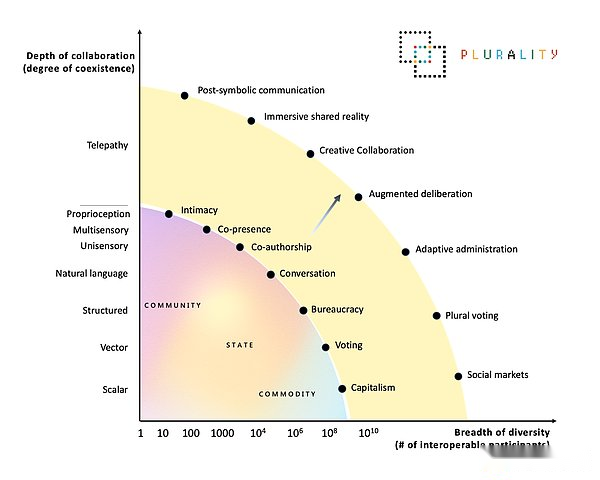 To some extent, this framework is completely reasonable.Philosopher Nasim Taleb likes to quote Geoff and Vince Graham to describe his rejection of “scale-independent universalism”: “At the federal level, I am a liberal;At the state level, I am a Republican; at the local level, I am a Democrat; at the family and friends level, I am a socialist.”Multiple philosophy attaches great importance to this and recommends adopting different mechanisms on different scales.
To some extent, this framework is completely reasonable.Philosopher Nasim Taleb likes to quote Geoff and Vince Graham to describe his rejection of “scale-independent universalism”: “At the federal level, I am a liberal;At the state level, I am a Republican; at the local level, I am a Democrat; at the family and friends level, I am a socialist.”Multiple philosophy attaches great importance to this and recommends adopting different mechanisms on different scales.
On another level, it sometimes feels like a “multi-dimensional atmosphere” is like an umbrella that brings together very different concepts, and the reasons for accepting or rejecting them are very different.For example, “It is very important to establish healthy connections between people” and “the voting mechanisms need to consider the difference in the degree of connection” are completely different statements.It is entirely possible to use paired quadratic financing to build a new and better UN to finance cooperation and world peace, but at the same time, “creative cooperation” is overrated, and the great work should be an authorvision.Part of this seemingly inconsistency is due to the diverse authorship of the book: VR and brain communication, for example, is written by Puja Olhaver, in addition to Glenn and Audrey.But this is the weakness of all philosophy: 19th-century liberalism combines democracy and markets, but it is a comprehensive work of many people of different beliefs.To this day, many people like democracy and doubt the market, or like the market and doubt democracy.
So, a question worth asking is: If your background intuition about various issues is different in some ways from the “pluralistic atmosphere”, can you still benefit from pluralistic thought?I think the answer is yes.
Is pluralism compatible with the future of crazy indexes?
By reading pluralism, you might get the impression that while Glen and Audrey’s meta-level vision of dialogue and governance are very appealing, they don’t really see what’s going to happen in the future with overly radical technology.Here are the specific goals they hope to achieve:
We believe it can increase economic output in the workplace by 10% and increase growth by one percentage point.
In the health field, we believe it can extend human lifespan by 20 years.
In the media field, it can bridge the disagreements created by social media, provide sustainable funding, expand participation, and significantly increase press freedom.
For the environmental field, it is at the heart of solving most of the serious environmental problems we face, and may even be more important than traditional “green” technologies.
In terms of education, it can subvert the linear structure of current school education, thereby achieving more diverse and flexible lifelong learning paths.
These are all very good results and are also ambitious goals for the next decade.But the goals I want to see from a society with advanced technology are larger and more profound than these.As I read this part, I remembered my recent description of the Future Museum in Dubai and Tokyo:
However, the solutions they propose are mostly fine-tuning, trying to make the world more gentle and friendly to people with these diseases: robots can help people guide, such as writing braille on business cards, and so on.These are very valuable things that can improve the lives of many people.But they are not what I expect to see in the future museum in 2024, what I want to see is a solution that people can really see and hear again, such as optic nerve regeneration and brain-computer interfaces.
Dubai’s attitude toward these issues deeply touched my soul, but Tokyo did not.I don’t want a future that is 1.2 times better than it is now, enjoying a comfortable life of 84 years rather than 70 years.What I want is a future that is ten thousand times better than now… If I become weak due to illness and live in an environment that still makes me comfortable despite the illness, it is of course an improvement.But what I really want is technology that can fix my stuff and make me strong again.
Dubai is an interesting example because it also uses another technique that deeply touched my soul: geological engineering.Today, the use and risks of geological engineering are still in a rather local range: artificial rainfall is being carried out in the UAE, and some blame the recent floods in Dubai, despite unanimous opposition from experts.However, there may be greater rewards tomorrow.Solar geological engineering is an example: instead of reorganizing our entire economy and society to keep CO2 at a reasonable low level and keep the earth at a reasonable cool temperature, there is another possibility that the cooling target of 1-4 degrees Celsius is neededJust spray the air with proper salt.Today, these ideas are still highly speculative, and it is too early to talk about science, and cannot make scientific commitments or use them as excuses for inaction on other things.Even more mild proposals like artificial lakes can cause parasite problems.
But as this century progresses, our ability to understand the consequences of these actions will improve.Just as early drugs are often harmful and today they can save lives vitally, our ability to heal the planet is likely to undergo a similar transformation.
But even after the scientific question becomes easier to understand, another real big question hangs over our heads: How exactly should we manage such things?
Environmental geopolitics is already a big problem today.Disputes about river water use rights have already existed.These issues will become more stakeholder if transformative continental or world-scale geological engineering becomes feasible.
Nowadays, it seems hard to imagine any other solution besides a few powerful countries uniting to decide everything on behalf of mankind.But the idea of pluralism is likely to be our best chance to come up with better solutions.The idea of common property that certain resources or environmental characteristics can be shared among multiple countries, even non-state entities responsible for protecting the natural environment or future interests, seems convincing in principle.The challenges of history have been that these ideas are difficult to formalize.Pluralism provides a series of theoretical tools for this.
If we look back from geological engineering issues and think about the category of “crazy exponential technology” in general, we may feel that there is a tension between pluralism and technologies that lead to exponential growth in capabilities.If different entities in society move on a linear or slightly superlinear trajectory, then the slight difference at time T is still a slight difference at time T+1, and therefore the system is stable.But if the progress is super exponential, then the slight difference at that time will become a huge difference at this time. Even if calculated in proportion, the natural result will be that an entity that surpasses everything else will be born.
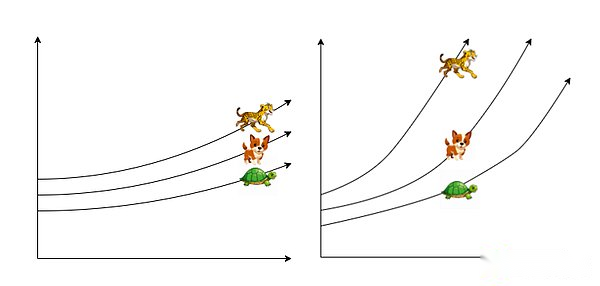
Left picture: Slightly super linear growth.A small difference at the beginning becomes a small difference at the end.Picture right: Super exponential growth.Small differences at the beginning can quickly turn into very large differences.
This has actually always been a trade-off.If you are asking which 18th-century institutional organization looks the most “diversified”, you may think of deep-rooted large family relations and industry associations.However, the Industrial Revolution swept away these and replaced them with economies of scale and industrial capitalism, which are often considered to be the cause of huge economic growth.
However, I think the static diversification of the pre-industrial era is essentially different from the pluralism of Glen and Audrey.The static diversification before the Industrial Revolution was shattered by what Glen called “increasing returns.”Diversity has specially designed tools to handle it: democratic mechanisms that provide funding for public goods, such as quadratic financing, and more limited ownership, especially if you create something very powerful, you can only own what you have.Partial ownership of the thing created.With these technologies, we can prevent the hyper-exponential growth of the scale of human civilization from turning into hyper-exponential growth of resource and power inequality.Instead, we design property rights in this way: the water rises and the ship rises.therefore,I think the exponential growth of technical capabilities and the concept of diversified governance are highly complementary.
Does pluralism mean a weakening of excellence and professionalism?
There is a political idea that can be summarized as “elite liberalism”: it values the benefits of free choice and democracy, but acknowledges that some people are investing much higher than others, and hopes to impose friction or restrictions on democracy, thus giving the elite moreMore room for maneuver.Some recent examples include:
-
Richard Hanania’s concept of “Nicetsche Liberalism”Trying to reconcile his long-standing belief that “some people are superior to others in a deeper sense… society takes disproportionate benefits from a few scientific and artistic geniuses”, he is increasingly aware of the liberal democracyBenefits, it avoids truly horrible outcomes while not over-consolidating the status of specific elites with bad ideas.
-
Garrett Jones’ “10% reduction in democracy”The theory advocates more indirect democracy through longer term, more appointments and similar mechanisms.
-
Bryan Caplan cautiously supports freedom of speech, believes that freedom of speech at least gives anti-elites the opportunity to form and develop ideas under hostile conditions, and even an open “ideological market” is far from fully guaranteeing good ideas to win wider public opinion.
There is similar debate on the other side of the political field, although there is often a focus on “expertness” rather than “wisdom”.The types of solutions advocated by those with these claims often involve compromises between democracy and chaebolism or technological domination (or something worse than the two) as a way to try to screen for excellence.But what if we don’t make this compromise, but instead work harder to solve the problem directly?If we start from such a goal:We want an open and diverse mechanism that allows different people and groups to express and execute their different ideas so that the best can win, so we can ask the question: How do we optimize the system based on this idea?
One possible answer is: predict the market.
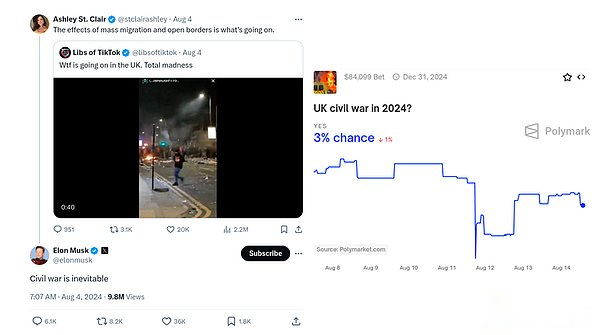
Left picture: Musk declares British civil war“Inevitably”.Picture right: Polymarket gamblers, who are really involved, think that the probability of civil war is…3%(I think this probability is too high, but I also bet)
Predictive markets are a place where different people can express their opinions on what will happen in the future.The advantage of predicting the market comes from the view that when people have a “stakes”, they are more likely to give high-quality opinions, and over time, the quality of the system will also improve, and the opinions are incorrect.People will lose money, and people with the right opinions will make money.

It should be noted that while forecast markets are diverse in the sense of openness to different participants, they are not the case in Glen and Audrey’s eyes.This is because they are a pure financial mechanism: they do not distinguish whether one person bets $1 million or one million unrelated people bets a total of $1 million.One way to diversify the forecast market is to introduce per capita subsidies and prevent people from outsourcing the bets they make with these subsidies.There are some mathematical arguments that this does better than the traditional forecasting market in stimulating participants’ knowledge and insights.Another option is to run a forecast market, while running a Polis-style discussion platform that encourages people to submit reasons for their belief in something—perhaps using soul binding proofs from past market records to determine who happens more weight.
Predictive markets are a tool that can be applied to many forms of factors and environments.One example is traceable public goods financing, where public goods only receive financial support after they have an impact and have enough time to evaluate the impact.RPGF is often considered to be combined with an investment ecosystem where upfront funds for public product projects will be provided by venture capital funds and investors who predict which projects will succeed in the future.Both the post-event part (evaluation) and the pre-event part (prediction) can become more diversified: the former adopts some form of secondary voting, while the latter adopts per capita subsidies.
The book “Plurinationaly” and related articles are not really discussed from the perspective and perspective of “good and bad”, but only draw more benefits from more different perspectives.On the “resonance” level, I think there is indeed a sense of tension.However, if you believe that the measurement of “good and bad” is very important, then I don’t think these focus is incompatible in nature: there are many ways to adopt one of the ideas to improve what is designed for othersmechanism.
Where can these ideas be applied first?
The most natural application of the concept of pluralism is the social environment, and our society is already facing the question of how to improve cooperation among different and interacting tribes while avoiding centralization and protecting participants’ autonomy.
I personally like three experiments most: social media, blockchain ecology and local government.Specific examples are as follows:
-
Community Notes on Twitter, its notes ranking system has been designed to support notes that have received support from a wide range of participants.A natural way to improve community notes is to find ways to combine it with the forecast market, thereby encouraging sophisticated participants to tag posts that will gain attention faster.
-
Anti-fraud software for users.Message Checker, along with Brave browsers and some crypto wallets, are early examples of the software paradigm that actively work on behalf of users and protect users from threats without the need for centralized backdoors.I expect software like this to be very important, but there is an inherent problem of decision making, i.e., deciding what is a threat and what is not a threat.Pluralism theory can help solve this problem.
-
Public product financing in the blockchain ecosystem.The Ethereum ecosystem uses a lot of quadratic financing and traceability financing.Multiple mechanisms can help limit collusion among these mechanisms and subsidize cooperation among various parts of the ecosystem facing competing pressures (L2 expansion platform and wallet).
-
Network countries, popup cities and related concepts.A new volunteer community formed online based on common interests and then “concretized” offline, there are many needs: (1) reduce internal dictatorship, (2) more cooperation with each other, (3) with their placeMore cooperation in actual jurisdiction areas.Multiple mechanisms can help improve these three aspects.
-
Publicly funded news media.Historically, the media has been funded either by listeners or by the administration of centralized states.Multiple mechanisms can achieve more democratic mechanisms, which also explicitly strive to connect the poles, reducing rather than exacerbating polarization.
-
Local public goods.There are many hyperlocal governance and resource allocation decisions that can benefit from diversified mechanisms; my crypto city-related article contains some examples.A possible starting point is a quasi-city city with highly complex residents, such as universities.
Nowadays, I think the right way to think about “pluralism” is to see it as a “intuitive pump” of social mechanism design philosophy to better protect individuals and communities’ freedoms, achieve large-scale collaboration, and minimize the two polesDifferentiation.The above environments are a good foundation for experiments because they contain (i) real-world problems and resources, and (ii) people who are very interested in trying new ideas.
In the future, there will be broader political issues regarding the structure of the world in the 21st century, including what level of sovereignty individuals, companies and countries have, how equal or unequal the world will eventually become, and in what order will it be.Development and what functional attributes will be possessed.Whether it is the “pluralist atmosphere” or the specific meaning of the multi-mechanism design theory, there is still a lot to say about these topics.
There are often multiple conflicting methods for the same problem.For example, pluralism theory means that if a group or mechanism is not related to other dominant mechanisms in society and can bring about something unique, then the improvement of that group or mechanism is valuable.But, as a popular input party, billionaires inject irrelevant activities into a world dominated by nation-states with extremely similar internal decision logics, or more active nation-states as a popular input party, will be diverseSex injected into a world dominated by homogeneous billionaire capitalism?Your answer is likely to depend on your original feelings about these two groups.
For this reason,IIt is better to think that pluralism is not understood as an overarching alternative to your existing framework for thinking about the world, but as a complement to it, these basic ideas that can make various mechanisms better.



